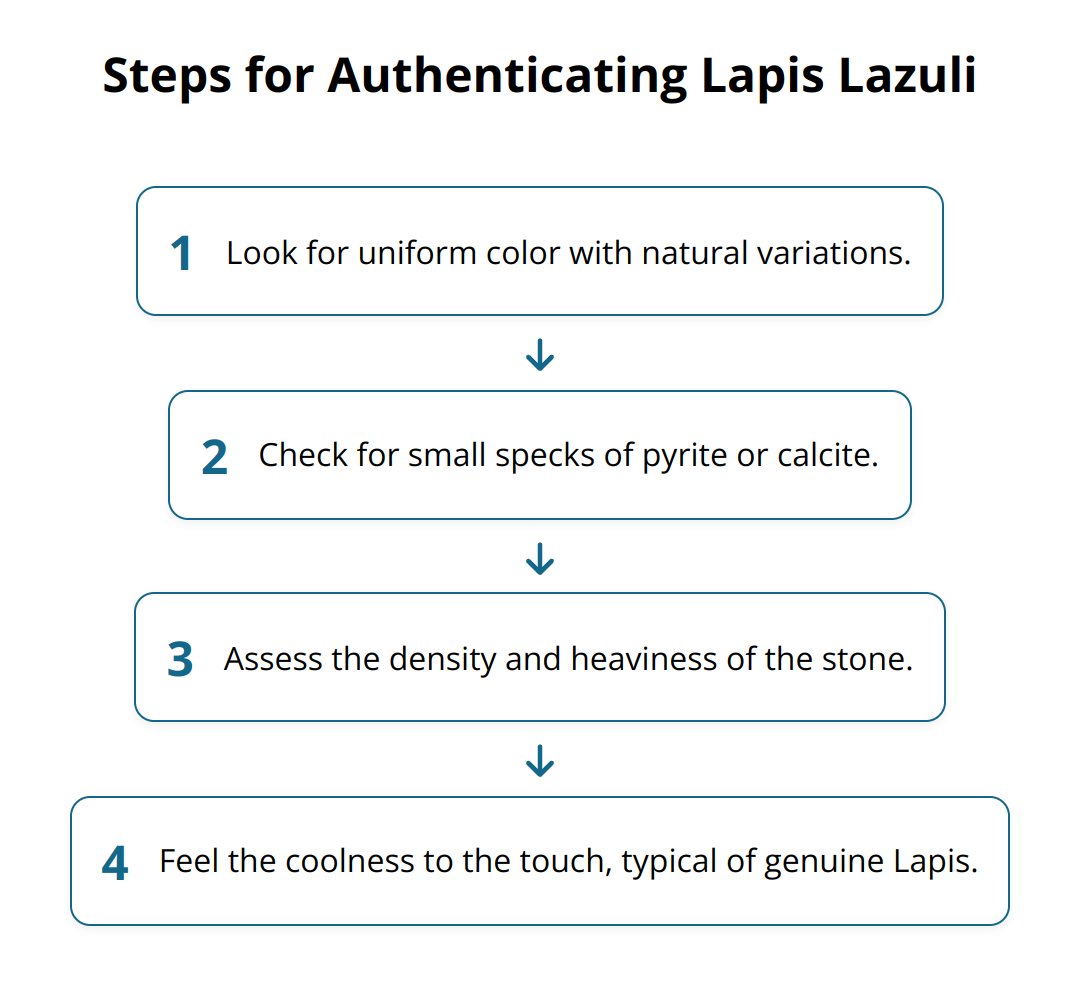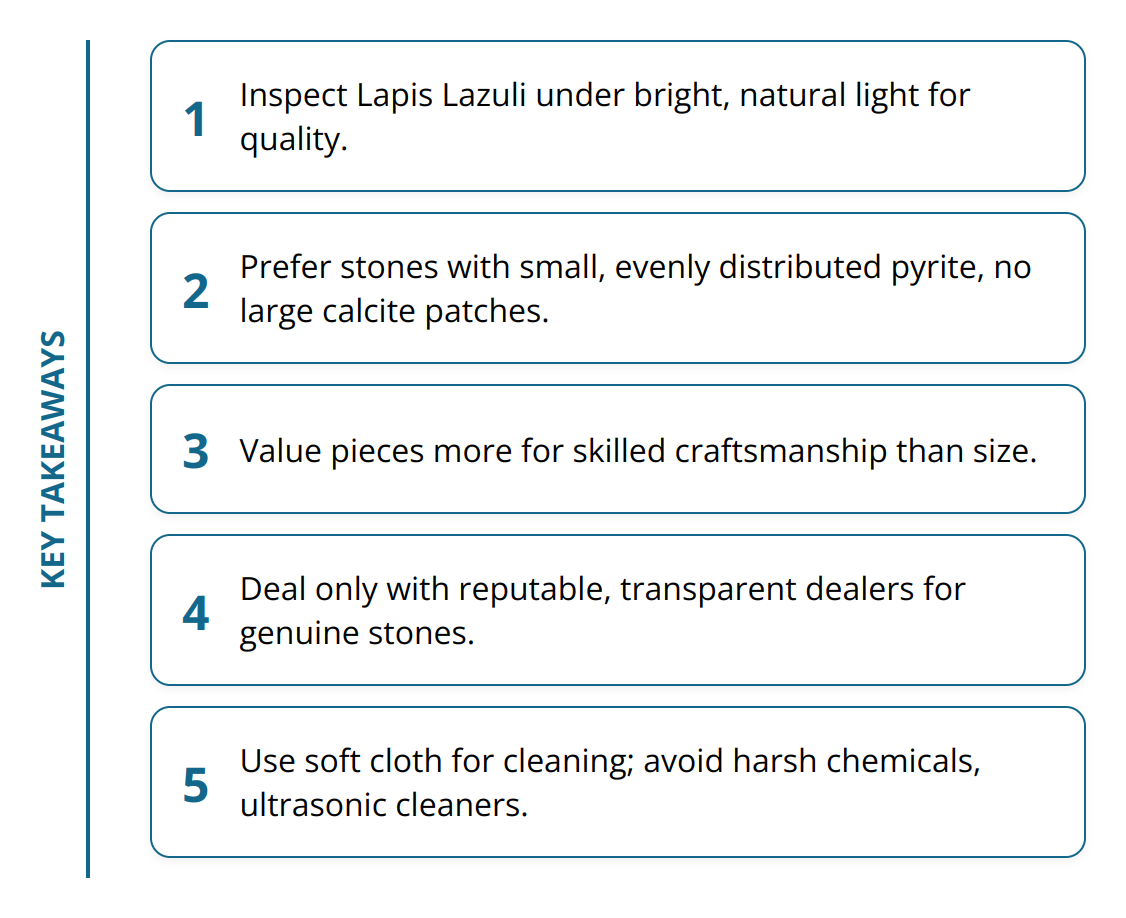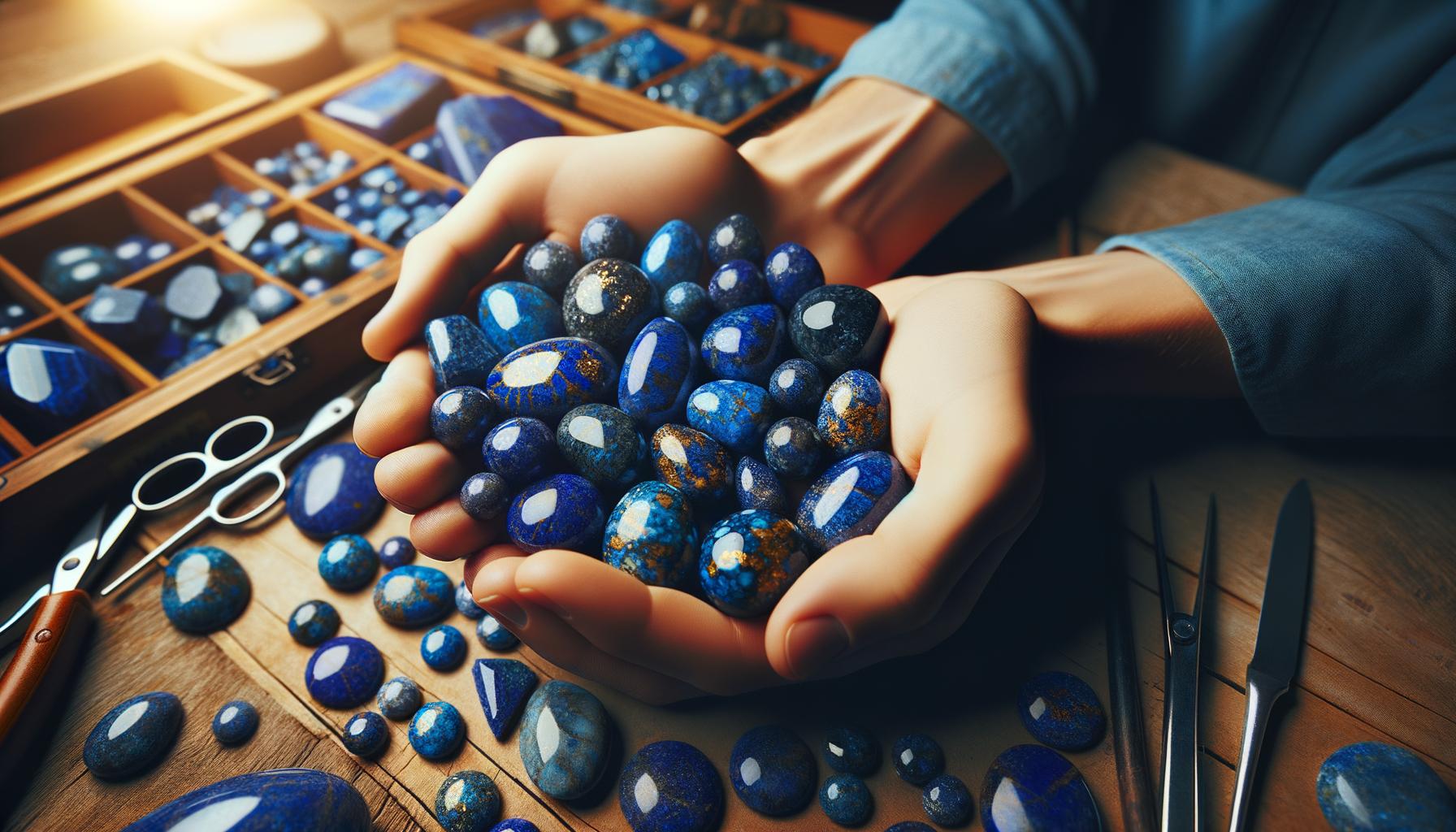Lapis Lazuli, with its deep celestial blue, has been a symbol of royalty and wisdom for centuries. Identifying the grades of this precious stone, however, can be complex.
At crystalcheta.com, we’re here to guide you through the intricacies of grading, valuing, and caring for Lapis Lazuli. Equipping yourself with knowledge is the first step toward becoming a discerning collector.
Grading Lapis Lazuli
Understanding the Lapis Lazuli grades is pivotal for collectors. This stone’s value is judged primarily on its color, but inclusions and texture also play a crucial role. Each characteristic needs to be examined closely to make informed decisions about your collection.
The Paramount Importance of Color
The color of Lapis Lazuli varies from deep celestial blue to lighter shades. A uniform, deep blue color without visible white patches (calcite) is highly prized, signifying a top-grade stone. A hint of violet in the blue can also indicate a higher quality. Stones with vibrant, consistent coloration typically fetch higher prices in the market.
Inclusions: Pyrite and Calcite
Inclusions in Lapis Lazuli, particularly pyrite and calcite, are like fingerprints; they tell the story of each stone. Pyrite, with its golden flecks, can enhance the stone’s appearance, making it more appealing if evenly distributed. In contrast, visible calcite patches, especially if they disrupt the blue color, lower the stone’s grade and value. A stone without any calcite and minimal pyrite is considered premium.

Transparency and Texture
While Lapis Lazuli is generally opaque, fine specimens might exhibit a slight translucency, which is usually a sign of high quality. The texture is another important criteria; the best stones are smooth and finely grained. Coarse or uneven texture, indicating lower density and quality, is less desirable.
Practical Tips for Collectors
- Inspect under good light: Always examine Lapis Lazuli in bright, natural light to get an accurate sense of its color and clarity.
- Look for uniformity: A consistent, deep blue color throughout the stone is a sign of high quality.
- Check for inclusions: Small, evenly distributed pyrite flecks are acceptable, but avoid stones with prominent calcite patches.
- Feel the texture: Prefer stones that are smooth to the touch, as this is an indicator of fine grain and higher quality.

For collectors, ensuring you’re getting the real deal is also critical. We have a detailed guide on distinguishing genuine Lapis Lazuli from fakes that further aids in making informed decisions.
By focusing on these aspects, collectors can grade Lapis Lazuli with confidence, adding only the finest specimens to their collection. The next step is understanding how to care for and maintain the beauty and value of these stones, ensuring they remain vibrant and lustrous over time.
Valuing Lapis Lazuli
In the world of gemstones, certain factors play a vital role in determining the value of Lapis Lazuli. A collector must be acutely aware of these nuances to make informed decisions when adding to their collection. This segment explores the aspects of rarity, origin, size, shape, and treatments that affect Lapis Lazuli’s worth.
Rarity and Origin: Markers of Authenticity
Lapis Lazuli’s value significantly hinges on its rarity and the location it comes from. Afghanistan, known for the highest quality Lapis Lazuli, offers stones that are unmatched in color and texture. The less common the Lapis Lazuli, especially pieces free of calcite with a rich blue hue, the higher its value. It’s essential to research the provenance of a Lapis Lazuli piece before purchasing it, as this can greatly influence its authenticity and value.
Size and Shape: Bigger Isn’t Always Better
While larger pieces of Lapis Lazuli are impressive, size alone doesn’t dictate worth. The craftsmanship in shaping the Lapis, whether it be into beads, cabochons, or intricate carvings, can elevate a stone’s value. An expertly cut piece that maximizes the stone’s natural color and minimizes visible calcite or pyrite inclusions is highly sought after. The shape should complement the stone’s natural beauty without sacrificing its integrity.
Treatment and Enhancements: Keep It Natural
The gemstone market is awash with treated stones, but for Lapis Lazuli, natural is best. Treatments such as dyeing can enhance the color but greatly diminish the stone’s value and longevity. Enhancements that alter the stone’s natural state are viewed negatively by collectors. When considering a purchase, always inquire about any treatments the stone may have undergone. If the stone has been altered, its value should reflect this.
A guiding principle is to prioritize stones that have been minimally treated. Natural stones, even with some imperfections, are often more valuable than those that have been artificially enhanced to appear ‘perfect’.

Practical Tips for Valuing Lapis Lazuli:
- Verify the stone’s origin. Afghan stones are typically more valued.
- Choose pieces that are skillfully cut to enhance their natural appeal.
- Opt for stones with minimal to no treatment for lasting value.
- Research the market to understand current trends and prices.
By understanding these critical factors, collectors can navigate the market more effectively, ensuring they add only the most valuable pieces to their collection.
In further exploring the world of Lapis Lazuli, it’s beneficial to familiarize oneself with how to charge Lapis Lazuli to maintain its energy and vibrance. Additionally, understanding how to detect real vs. fake Lapis Lazuli can save a collector from potential pitfalls in their acquisition journey.
How does the grade of lapis lazuli affect its value and rarity for collectors?
The grade of lapis lazuli significantly impacts its value and rarity for collectors. Higher grades, with intense blue color and minimal calcite and pyrite, demand higher prices. The presence of the meaning of red aura, indicated by red flecks, adds uniqueness and increases its desirability among collectors.
Authenticating and Caring for Lapis Lazuli
When you’ve taken the leap into collecting Lapis Lazuli, ensuring your pieces are genuine and well-cared for is paramount. The market is flooded with imitations that can fool even the experienced eye, and neglecting proper care can diminish your gem’s luster and value. Here’s how to navigate these waters with confidence.
Tips on Buying Genuine Lapis Lazuli
Finding a reliable source for purchasing Lapis Lazuli is crucial. Opt for reputable dealers with transparent sourcing and quality assurance policies. Prioritize sellers who specialize in ethically sourced gems and who provide detailed information about the origin and treatment of their stones. Recommendations from seasoned collectors can also lead you to trusted vendors.
- Reputation Matters: Deal with sellers known for quality and transparency.
- Origin is Key: Value stones with clear, documented origins, especially from renowned locations like Afghanistan.
- Ask for Documentation: Request authenticity certificates or any proof of the stone’s natural state and origin.
For further guidance, our article on real vs. fake Lapis Lazuli offers invaluable insights.
Care and Maintenance of Lapis Lazuli
Lapis Lazuli, while durable, requires specific care to maintain its color and finish. Always store your Lapis Lazuli pieces separately to avoid scratches from harder stones. Regular cleaning should be gentle, using only a soft, dry cloth or a cloth slightly dampened with water, avoiding harsh chemicals or ultrasonic cleaners.
- Avoid Direct Sunlight: Prolonged exposure can fade its vibrant blue.
- Gentle Cleaning: Use a soft cloth; harsh cleaning methods can damage the stone.
- Proper Storage: Store separately in a soft pouch to prevent scratching.

Authenticating Your Gems
Even with careful purchasing, verifying the authenticity of your Lapis Lazuli is advisable. Look for uniformity in color and typical characteristics like pyrite flecks. Remember, genuine Lapis Lazuli feels dense and cool to the touch. In case of doubts, consider professional gemological testing for a conclusive verification.
- Density Test: Genuine Lapis is notably dense and heavy for its size.
- Coolness: Authentic Lapis Lazuli remains cool to the touch.
- Professional Verification: When in doubt, seek gemological testing from a certified lab.
Arming yourself with knowledge and adopting meticulous care practices will not only preserve the beauty and integrity of your Lapis Lazuli collection but will also ensure its enduring value. As you build your collection, remember that the journey is as rewarding as the destination, offering a fulfilling exploration into the rich history and timeless allure of Lapis Lazuli.
Final Thoughts
Lapis Lazuli remains a gem with unparalleled allure, symbolizing wisdom, and royal power across ages. Recognizing the grades and understanding its true value are foundational for any collector aiming to curate a compelling and authentic collection.

Here are some key takeaways:
- Color and Inclusions: The depth and uniformity of the blue color, along with the presence of pyrite and absence of calcite, dictate the stone’s grade and allure.
- Natural is Best: Stones that have undergone minimal to no treatment command higher value and integrity, reflecting their natural beauty.
- Provenance Matters: The origin of Lapis Lazuli contributes significantly to its value, with Afghan stones being some of the most prized.
- Care and Authenticity: Proper care and regular verification of your gems ensure they retain their beauty and value over time.
We encourage collectors to approach their passion with education and discernment, leveraging reputable sources and thorough knowledge to distinguish the gems that are truly worth adding to their collection. Remember, each piece of Lapis Lazuli carries a piece of history, making it not just an addition to your collection but a story to tell.
For anyone looking to deepen their understanding and explore the vast and vibrant world of gems, we invite you to discover more at crystalcheta.com. Here, you’ll find a treasure trove of information on crystals, stones, and precious metals, designed to guide you on your journey toward spiritual growth and healing through the power of nature’s wonders. Whether you’re a seasoned collector or just starting out, there’s always new knowledge to uncover and ways to enrich your collection and your life with the transformative power of gems.

